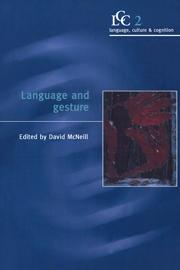Book contents
- Frontmatter
- Contents
- Acknowledgments
- Introduction
- Part 1 Gesture in action
- 1 Pointing, gesture spaces, and mental maps
- 2 Language and gesture: unity or duality?
- 3 The influence of addressee location on spatial language and representational gestures of direction
- 4 Gesture, aphasia, and interaction
- 5 Gestural interaction between the instructor and the learner in origami instruction
- 6 Gestures, knowledge, and the world
- Part 2 Gesture in thought
- Part 3 Modeling gesture performance
- Part 4 From gesture to sign
- Index
4 - Gesture, aphasia, and interaction
Published online by Cambridge University Press: 07 January 2010
- Frontmatter
- Contents
- Acknowledgments
- Introduction
- Part 1 Gesture in action
- 1 Pointing, gesture spaces, and mental maps
- 2 Language and gesture: unity or duality?
- 3 The influence of addressee location on spatial language and representational gestures of direction
- 4 Gesture, aphasia, and interaction
- 5 Gestural interaction between the instructor and the learner in origami instruction
- 6 Gestures, knowledge, and the world
- Part 2 Gesture in thought
- Part 3 Modeling gesture performance
- Part 4 From gesture to sign
- Index
Summary
Introduction
What is the scope of phenomena that have to be taken into account in order to describe how gesture is organized as intelligible action in human interaction? Here it will be argued that gesture as meaningful action is accomplished not by a speaker's hand alone, but instead through the relevant juxtaposition of a range of different kinds of semiotic materials which mutually elaborate each other.
The present chapter will probe the range of phenomena relevant to the organization of a gesture by looking at a rather special situation. Because of a massive stroke in the left hemisphere of his brain, Chil is able to speak only three words (Yes, No, and And). However, he is able to supplement this vocabulary with limited gestures, and to understand much of what other people say. His gestures have none of the syntax or other language properties of a sign language. Indeed, like his vocabulary, they seem more sparse and restricted than the gestures of people without brain damage. Despite these very severe restrictions on possibilities for expression through language, he is nonetheless able to engage in complicated conversation. How is this possible? By embedding the semiotic field constituted through his gesture in the talk and action of his interlocutors, Chil is able to both say something relevant and negotiate its meaning. His gestures do not stand alone, but instead count as meaningful action by functioning as components of a distributed process in which he creatively makes use of the language produced by others.
- Type
- Chapter
- Information
- Language and Gesture , pp. 84 - 98Publisher: Cambridge University PressPrint publication year: 2000
- 98
- Cited by



